What Solvents Can You Use With Castle Art Colored Pencils
Pigment Thinners and Colored Pencils
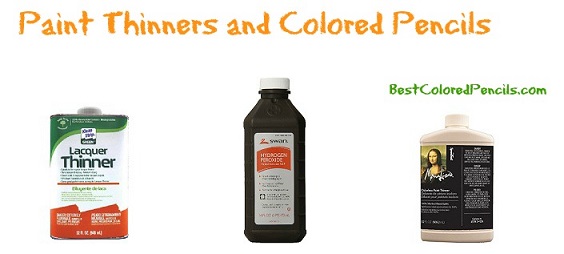
Updated by Brandon F. on July viii, 2020
Paint thinners can open upward the flexibility of a set of colored pencils. However, we become a lot of questions and comments in regards to paint thinners and their relationship with colored pencils. Some (of the many) questions include:
What exactly is paint thinner?
When is paint thinner supposed to exist used with colored pencils?
What is the best awarding technique to use?
What is the best pigment thinner brand?
…and the listing goes on!
Nosotros are here to help clear up some of these questions and accept a general discussion of paint thinners and how they can help to bring your colored pencil blending game up to the next level. We will also get over what we feel are the best paint thinners for various applications.
What is Paint Thinner?
A paint thinner is a solvent that is designed to thin upwards paints. This can accept both the benefit of lightening the intensity of color but also greatly aids in helping to blend one color with some other. You can open up your bachelor colour palette with a given prepare of colored pencils through proper blending techniques.

A typical bottle of pigment thinner
At that place are a wide variety of paint thinners to choose from. While their names and appearance might differ some, they practise share a common trait in that they will typically contain i of the several mutual solvents that give them the ability to thin paint.
These include things such as mineral spirits, acetone, toluene, turpentine, naphtha, and a few others. If you look at the ingredients section of whatever pop paint thinner in the store, you lot will likely see at least one of these ingredients.
When Do I Use Pigment Thinner Instead of "Regular" Blending?
This is a bit of a circuitous question and it depends on the type of colored pencils you have as well equally the level of blending you lot are afterward. Many people will use "traditional" blending techniques that include both pencil blending and dry blending.
Pencil blending is simply when you utilise pressure from your pencil tip to add multiple layers of colour. This, in turn, creates color blending. When you lot utilise extra levels of pressure level it is chosen burnishing, and it is a good way to further mix layers of color. Nevertheless, how much blending takes place is heavily dependent on the blazon of colored pencils you have.
Specifically, oil-based cores with very soft materials tend to blend much easier than harder, wax-based cores. In other words, pencil blending might exist all you demand and for others, it will inappreciably have whatsoever effect.
Dry blending is where you use a dry cloth, tissue, tortillon, or other soft material to blend layers without incorporating additional color or solvents to the mix. The key difference between dry out blending and pencil blending is that you are not adding boosted layers of color and are but mixing up what has already been laid down. While dry blending does have a more meaning impact than pencil blending, its effects will still be limited by the type of colored pencils y'all utilize and the softness of the layers.
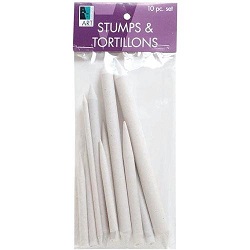
Tortillions are quite helpful for applying paint thinner to a sheet
That brings us to the topic at mitt: solvent blending. Every bit mentioned in a higher place, solvent blending involves calculation a solvent to your art piece instead of more layers of colour or mixing existing layers. This solvent "breaks downward" or thins the color, making it much easier to redistribute and mix.
Paint thinners work great for those times that you are trying to lighten upwardly the color tone some besides every bit when you are wanting to blend 2 colors into a unique new color. They are also groovy for those colored pencil sets that don't alloy very well by themselves or in cases where you desire to be able to exercise some blending without having to put down tons of additional layers.
Pigment thinners are also expert for areas where y'all wish to comprehend large areas of the page with subtle colour with minimal attempt. This tin can include things such as skies and distant valleys in landscapes, lite peel tones on faces, and metal sheens on buildings in industrial settings.
What Blazon of Paint Thinner Do I Use?
While paint thinners might all work in similar manners, they are not all the same. They come in differing concentration levels, thicknesses, smells, etc. We take heard stories of people finding random containers tucked away behind cabinets in their garage and using them for paint thinners with success, just we recommend sticking to the basics. We also tend to avoid industrial pigment thinners that are designed to work with pigment you would use on a house, deck, or other more demanding settings. This is because these thinners tend to be much too potent and the fumes tin can be quite overwhelming.
Having said this, nosotros recommend sticking to one of these three types of paint thinner: rubbing booze, turpentine, and safety cement thinner.
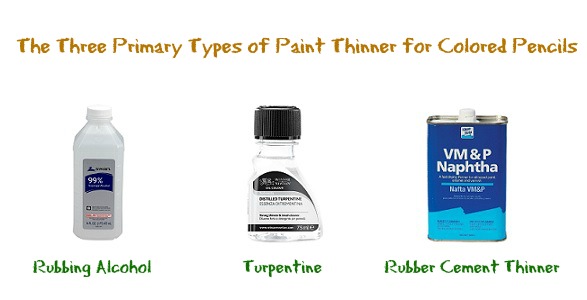
Rubbing alcohol is the mildest of the three and is adept for low-cal to mild blending. While it will break the binders of the colour some, you are going to demand several layers of thick color to run across significant results. Rubbing alcohol is likewise the easiest to come past since most people have a canteen lying around somewhere in their house. We exercise recommend sticking to lighter concentrations of information technology (75% or lower) as annihilation college could potentially remove too much color.
Turpentine is in the middle in regards to performance. It is the near common ingredient in many of the paint thinners you volition discover at the store, and for good reason. The turpentine breaks downwards the binders used in colored pencils and allows you to easily mix the colors. You will also run into more than significant results with less color than yous will with rubbing alcohol. Even so, it is easier to become overboard and remove more colour than yous want to and so outset dull.
Lastly, there is rubber cement thinner. This is the about powerful of the 3 paint thinners and should just be used in those times when you are looking to completely mix or remove colour. There is also quite a fleck of fume with rubber cement thinner so you lot may want to habiliment a mask or at to the lowest degree keep your confront a bit farther away until things dry. With condom cement thinner, less is more than, and you lot desire to try to avoid making more than ane or ii passes with it as you will simply remove color instead of blend it.
How to Use Paint Thinners on Colored Pencils
Everybody has their favorite technique and we aren't hither to proudly exclaim that we have plant the perfect method for blending because there isn't one! Instead, we encourage y'all to try a few dissimilar methods out and run into which ane works best for you and your chosen set of colored pencils. Yet, there are a few techniques and tips that we think everybody starting with paint thinners should follow.
First, test any new paint thinners on a separate sheet of the paper you are using. This may be a no-brainer to some, but it is worth mentioning. Don't test new pigment thinners out on your actual pieces of work! As well, information technology is important to have the scrap paper that yous use to be the same type of paper yous are using for your bodily work.
Paper thickness, roughness, and material composition play huge roles in how constructive thinners are. For instance, artist newspaper with shine surfaces may end upwardly losing nearly all of the color when a thinner is used since there is zippo for the color to bind to. Also, the thin newspaper might class wrinkles or creases when exposed to the liquid paint thinner.
2nd, offset small when applying to your bodily piece of work. Even when yous have a grasp of how a particular kind of pigment thinner will interact with your colored pencils and paper, it is all-time to start with small quantities to achieve your desired results. You will be surprised how far simply a little paint thinner will become, particularly if y'all are using a more ambitious product such equally turpentine.
In that location are a variety of ways to utilise thinner. Some people adopt dabbing a fleck of thinner on to a tissue or towel while others will prefer the preciseness of a tortillon. We know a few people who will also get some paper towel and wrap information technology around the tip of a pencil or pen and hold the paper towel in place with tape. This essentially gives them a "blending pencil" that they can utilize similar to a traditional colored pencil. Since the turpentine is easier to see, you lot can also utilise a paintbrush to "paint" some of it on too.
Recollect, there are no correct or wrong ways to apply thinner. You simply demand to try a few out and come across what works for you lot!
Once the thinner is applied, you then softly brighten the surface to your desired results. Again, showtime soft and tedious and see what sort of results you get. If you lot can't achieve your desired blend or colour then try adding a bit thinner and burnish some more. However, if you still can't become what yous are looking for later on a second application, you may need to add more layers of color, try a more ambitious thinner, or have to purchase a softer set up of colored pencils.
For some more full general tips, this explanation on how to use pigment thinners provides some more helpful data.
What is the Best Paint Thinner Brand?
The beauty of paint thinners is in their simplicity. As long as they contain one of the key ingredients listed to a higher place then they should perform similarly to the competition. Equally such, there aren't any large pros or cons from i brand to another. The biggest differences will be in the level of fumes and smells, as some of the paint thinners add together extra items to attempt to offset the somewhat pungent scent that thinners can emit.
Nosotros take listed a few of our choices of pigment thinners that will work beneath for your convenience.
Mona Lisa Odorless Paint Thinner

This is one of our favorite paint thinners. It has very little olfactory property and has the effectiveness of traditional turpentine, making information technology a happy medium for those looking to mix color simply not go overboard.
Bob Ross Odorless Paint Thinner
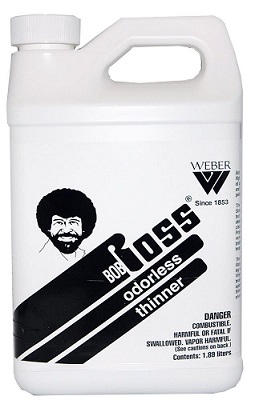
This Bob Ross Odorless paint thinner bumps things upwards a notch, making information technology useful for those after serious color blending and it tin can even be used with other oil-based mediums such as oil paints and oil pastels. Also, the strong fumes common with this caliber of paint thinner is for the nigh role absent-minded which makes information technology a lot easier to be around.
Swan Hydrogen Peroxide
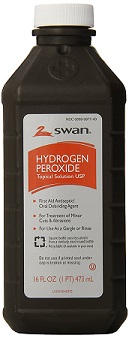
For those on a tight upkeep or wanting something subtle in its paint thinning, you tin can't get incorrect with the tried and tested hydrogen peroxide. Just about every canteen is the same. But exist sure to dilute it downward to 75% or less before applying to your paper.
Winsor & Newton Distilled Turpentine
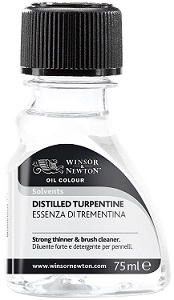
Winsor & Newton Distilled Turpentine comes in a small package but it packs a serious punch! This distilled turpentine is one of the best at blending color, even if there isn't a lot of colors out at that place to alloy. That makes it great for spreading color over large areas such as blue skies and as an added consequence it gives off an oil painting-like experience once dry. Simply it does have quite a smell to it so be prepared.
Still itching for more than information on pigment thinners and colored pencils? Youtube is loaded with corking tutorials and recordings of people using them together. One of our favorite ways to learn is to watch rather than read. This is ane of our favorite tutorials about how to blend colored pencils with pigment thinner:
Source: https://www.bestcoloredpencils.com/paint-thinners-colored-pencils/
Posted by: byrnehapingrese1948.blogspot.com

0 Response to "What Solvents Can You Use With Castle Art Colored Pencils"
Post a Comment